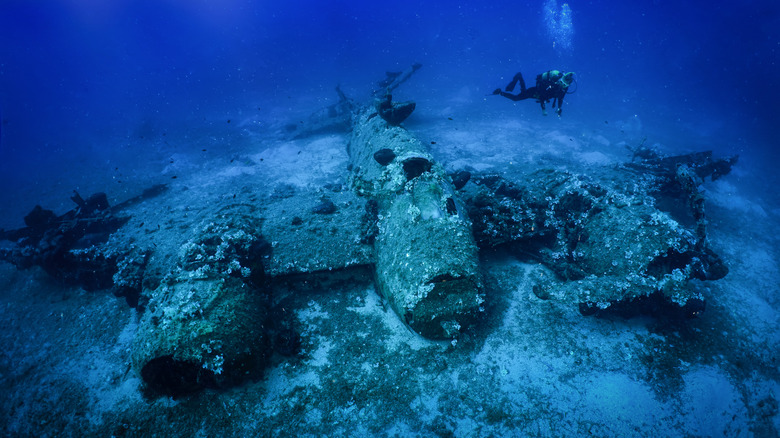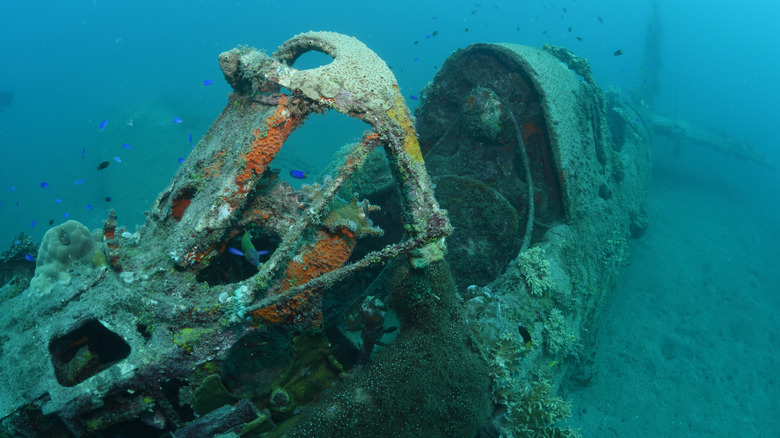АНУ-ын Далай цэргийн түүхэн сургалтын нууц: Мичиган нуурын ёроолд орших сөнөсөн байлдааны онгоцууд
Дэлхийн II дайны үед АНУ-ын Далай цэрэг нисэх онгоц тээгч хөлгүүд дээр шинэ нисгэгчдийг аюулгүйгээр бэлтгэх шаардлагатай болсон. Энэ нь Атлантын далай дахь Германы шумбагч онгоцнууд болон Номхон далайн Японы шумбагч онгоцнуудаас үүдэлтэй аюулыг зайлсхийх зорилготой байв. Энэхүү бэлтгэл сургуулилтын талбар нь Мичиган нуур байлаа. Тус нуурын ойролцоо байрлах Иллинойс мужийн Гленвьюд АНУ-ын Далай цэргийн бааз байсан нь энэхүү нуурыг сонгоход голлон нөлөөлсөн.
Тусгай хөлгүүд дээр нисэх онгоц тээгчийн нөхцөлийг дуурайлган, SS Seeandbee болон Greater Buffalo нэртэй хажуугийн дугуйтай уурын хөлгүүдийг онгоц тээгч хөлөг болгон хувиргасан. Эдгээрийг USS Sable болон USS Wolverine гэж нэрлэж, тэдгээр нь АНУ-ын Далай цэргийн хэрэглэж байсан хамгийн сонирхолтой хөлгүүдийн нэг болсон юм. Хэдийгээр эдгээр хөлгүүд зэвсэггүй байсан ч сургалтын хөтөлбөрт чухал үүрэг гүйцэтгэсэн.
1942 оноос дайны төгсгөл хүртэл 15,000 орчим нисгэгч, тэр дундаа ирээдүйн Ерөнхийлөгч Жорж Х.В. Буш, эдгээр хөлгүүд дээр хөөрөх, буухыг суралцсан. Бэлтгэлийн үед осол гаргалгүй нисгэгчид амьд үлдэхийг зорьж, тэдгээр ослын үед хэд хэдэн Grumman F4F Wildcat болон Douglas SBD Dauntless онгоцууд Мичиган нуурын ёроолд живсэн байна.
Сургалтын явц дахь ослууд ба сэргээн засварлах ажиллагаа
Мичиган нуурын усан дотор олон онгоцны осол гарсан бөгөөд онгоцуудыг сэргээн засварлах ажил 1980-аад оноос эхэлсэн. A and T Recovery зэрэг бие даасан сэргээн засварлагч бүлгүүд 40 орчим онгоцыг сэргээн засварласан байна. Холбооны байгууллагууд болон Далайн түүх, өвийн хөтөлбөр зэрэг байгууллагууд ч мөн адил сэргээн засварлах үйл ажиллагаанд оролцож, онгоцуудыг илрүүлэх, тодорхойлох, сэргээн засварлах ажлыг хийж байна.
Мичиган нуурын цэнгэг ус нь онгоцуудыг зэврэлтээс хамгаалж, олон жилийн турш хадгалж чадсан. Зарим тохиолдолд, онгоцны анхны будаг, цэргийн тэмдэглэгээ тодорхой харагдаж байсан бөгөөд энэ нь сэргээн засварлах ажилд чухал ач холбогдолтой болсон. Гэсэн хэдий ч нуурын ёроолд амьдардаг инвазив Quagga хясаанууд металлд муугаар нөлөөлөх тул сэргээн засварлалт хойшлогдөж магадгүй.
Түүхэн ач холбогдолтой эдгээр онгоцуудыг сэргээн засварлах ажил нь цаг хугацааны асуудал болж байна. Энэ онгоцууд нь АНУ-ын цэргийн түүхийн нэгэн чухал хэсэг бөгөөд хэрвээ сэргээн засварлах ажил хүчтэй явагдахгүй бол удахгүй энэ түүхийн нэг хэсэг алдагдаж магадгүй юм.
Эх сурвалж:
There Are Still A Lot Of Sunken Warplanes At The Bottom Of Lake Michigan: Here’s Why – SlashGear
When Lake Michigan was used practicing carrier takeoff and landing during WWII, naval air operations didn’t always go quite as planned.
Мэдээний дэлгэрэнгүй:
At the height of World War II, the U.S. Navy faced a critical training dilemma: how to safely prepare thousands of new pilots for carrier landings without exposing them to the very real threats posed by German U-boats in the Atlantic and Japanese submarines in the Pacific. The solution was Lake Michigan. What made this inland lake so ideal wasn’t just its seclusion, but the fact that the Navy already had a presence nearby in Glenview, Illinois, where they expanded operations between 1923 and 1942, building hangars, airfields, and landing strips across the area.
Advertisement
To replicate carrier conditions, the Navy stripped two sidewheel paddle steamers, the SS Seeandbee and Greater Buffalo, to their hulls and rebuilt them with makeshift aircraft carriers, adding in flat wooden flight decks to serve as floating runways. These were renamed as the USS Sable and USS Wolverine, which might be the strangest warship ever used by the U.S. Navy. While these carriers were unarmed and unconventional, they proved to be vital for the training program.
From 1942 until the end of the war, around 15,000 Navy pilots, including future President George H.W. Bush, learned to take off and land on these converted vessels. Crashes were expected, but the idea was to train hard and survive mistakes.
Advertisement
Training mishaps and the planes that never came back
As thousands of naval aviators cycled through training on these unconventional freshwater flattops, the intense pressure to master carrier takeoffs and landings led to regular mishaps. Among the casualties were Grumman F4F Wildcats and Douglas SBD Dauntless dive bombers, which was considered to be one of the best American planes used in WW2. However, there was little time to dwell on these losses. With World War II raging overseas, the priority was to train as many pilots as possible, as quickly as possible. And so, one by one, aircraft sank silently into Lake Michigan.
Advertisement
Although US Coast Guard vessels patrolled the lake during exercises to rescue pilots and mark locations of downed aircraft, many aircraft weren’t recoverable. Today, a lot of them still remain at the bottom, acting as a submerged archive of a secret training ground that helped win a global war.
Preserving and recovering a forgotten fleet
In the 1980s, independent recovery groups like A and T Recovery began recovering aircraft and have been able to recover around 40 planes. Organizations such as NOAA and the Naval History and Heritage Command have also joined the recovery effort and are deploying sonar, remotely operated vehicles, and diver surveys to locate, identify, and, when possible, recover these relics.
Advertisement
Unlike saltwater, which rapidly corrodes metal, the fresh and oddly clear waters of Lake Michigan not only reveal old shipwrecks, but also act as a natural time capsule and preserve many of the aircraft for decades. In some cases, even the original paint and military markings are still visible when a plane is first rediscovered. This has made restoration not just possible but deeply meaningful. Recovered aircraft are now on display across the country, from the SBD Dauntless dive bomber displayed at the Kalamazoo Aviation History Museum in Michigan to the SB2U-2 Vindicator at the National Naval Aviation Museum in Florida, where visitors can witness the painstaking restoration of these historically significant planes.
Advertisement
Yet preservation is no longer guaranteed. Quagga mussels, an invasive species, have now colonized much of the lakebed. They attach themselves to aircraft hulls at depths of several hundred feet and excrete acid that eats away at the metal, accelerating the decay of these submerged war relics.
While a number of the estimated 130 downed planes have already been recovered, the clock is ticking for the ones remaining. This underwater fleet is more than rusting metal, it’s a submerged chapter of American military history. And without accelerated preservation efforts, that chapter may soon be erased beyond recovery.




